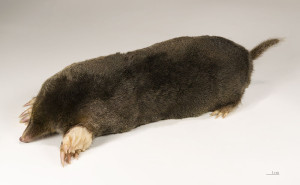I’ve read quite a bit of Meyer (honestly, more than I cared to). He’s made some pretty outrageous (and wrong) claims, but so far, I have never read anything by the man that is more stupid than what he says at the bottom of page 214.
Sometimes similarity appears between species where it cannot be explained by inheritance from a common ancestor (e.g., the similar forelimbs on moles and mole crickets) and, at the very least, there are other possible explanations for sequence similarity.
In the first place, similar gene sequences might have evolved independently on two parallel lines of descent starting with two different genes, as the hypothesis of convergent evolution asserts. Recent examples of convergent genetic evolution now abound in the literature of molecular and evolutionary biology.13 For example, molecular biologists have discovered that both whales and bats use similar systems—involving similar genes and proteins—for echolocation. The striking similarity of these systems used in two otherwise disparate mammalian species has led biologists to posit the parallel evolution of echolocation, including the gene sequences and proteins that make it possible, from a common ancestor that did not possess this system.14
Here’s what Meyer thinks are similar.
and
Yeah, I guess that a creationist with no training in anatomy could make the mistake that these limbs are similar. I mean, they are both in the front part of the animal and they both have pointy things on the end that are used for burrowing.
Of course, that’s an example of convergent evolution. When two structures are used for the same purpose, then over time, they will tend to both optimize for that function.
Why does Meyer think that these two forelimbs would have similar genetic sequences? Or that they should be inherited from a common ancestor. The fact that he even brings this up is mind boggling.
Meyer is basically saying that an X-Wing fighter is similar to a Fiat500 because they both are red and white and provide transportation.
Just ignore the fact that one can travel faster than the speed of light, one has weapons, one can seat more than one person, one has wheels… they are basically similar.
While the two limbs are superficially similar, biologists, unlike creationists, actually look at the structures with an eye for detail. The forelimbs of the common mole are inherited from the first tetrapod to walk on dry land. Just like every other tetrapod on the planet (that’s mammals, birds, reptiles, and amphibians).
At the shoulder there is a big thick bone. It’s connected to two thinner bones. Those are connected to a mass of bones. And those connect to five digits with some kind of claw or nail at the end of the digit. Every animal that is a mammal, bird, reptile, or amphibian shares this exact pattern.
Horses, for example, have a modified limb with four of those digits greatly reduced or missing all together. The middle digit for horses is greatly enlarged with a HUGE nail. Horses, very literally, run on their middle fingers. Flying animals on the other hand have other changes to that same bone structure. Bird wings are hyper extended digits 1, 2, and 3. Bat wings are made of hyper extended digits 2-5 and pterasaur wings have a hyper extended digit 4. Even the cetacean forelimbs have the same structure (because they evolved from land dwelling mammals), one big bone, two smaller bones, mass of bones, and five digits.
These are example of homologous structures. They are modified derivations from the same structure.
The mole is a mammal and has that bone structure.
The mole cricket (in spite of the name*) is an insect. This may come as a surprise to Meyer, but insects’ and mammals’ common ancestor was before even the Cambrian. This is basically the split between protosomes (mouth first) and dueterosomes (anus first). A split that happened before the Cambrian. I won’t get into the history of insects, because they are gross. But you might take a look here for some starting information.
But, the insect ‘skeleton’ is on the outside, even a 1st grader knows that (I just checked). It’s NOTHING like the mammal forelimb and no one ever has thought or said that it would be (except creationists).
As a fun aside, I found out where Meyer may have gotten this example. The book Explore Evolution: The Arguments For and Against Neo-Darwinism by (shockingly), Stephen C. Meyer and (among others) Paul Nelson, whom we met in this anecdote that Meyer mentions later in Darwin’s Doubt. Explore Evolution was intended to be a text book (of sorts), but had a significant number of things wrong with it (PDF) and this example specifically mentions Meyer’s use of the cricket and mole example.
Nested patterns of shared similarities between species play an important role in testing evolutionary hypotheses. “Homology” is one term used to describe these patterns, but scientists prefer other, more clearly defined terms. Explore Evolution would have done well to accurately present the way scientists talk about this issue, instead of building two chapters around a misguided attack on a particular word with a meaning that dates to pre-evolutionary attempts at understanding the diversity of life. Explore Evolution‘s use of the term promotes confusion and obscures the actual ways in which scientists use the term, and more modern concepts. Explore Evolution‘s authors could have found those modern concepts clarified in the writing of David Wake, work they cite and quote inaccurately, obscuring the point he and others have made about the importance of using concepts which reflect modern biology, not a term which predates evolutionary thinking. The chapter badly mangles key concepts, and repeats creationist canards, without presenting the actual state of science.
So here, Meyer reuses a wrong argument from a book that was critiqued years ago as if it was still true. Thus the lies continue. This isn’t because he’s ignorant. Meyer is purposefully lying to people, like my commenter on this blog who still hasn’t answered the question “Why does he consider Meyer a reliable source in spite of the dozens of documented lies and mistakes in this book?”
What is homology, in the actual science usage (from the NCSE link above)?
Homology is similarity in structure and position that occurs because a trait occurred in a common ancestor. If the similarity is not due to common ancestry, the structures would not be homologous. Biologists test alternative explanations, including shared function, natural laws, and other constraints. Like homology, these effects are all testable. Furthermore, similarity in shape, as between mole cricket forelimbs and the paws of a mole, is not homology. No one has ever suggested such a thing, and Explore Evolution is grossly misleading in suggesting otherwise.
By extension, this applies to Darwin’s Doubt.
I have to repeat this. No one, except for creationists whose goal is to confuse rather than educate, thinks that the shovel-like shapes of mole and mole cricket forelimbs are due to common ancestry.
Now, that doesn’t mean that moles and mole crickets do not have a common ancestor. They do, back before the Cambrian, as I mentioned previously. But at the time, fish weren’t even around yet. The idea of a specialized structure for movement wasn’t really around yet and certainly not one that specializes in digging.
No, these two vastly different organisms have similarly shaped forelimbs not because the forelimb came from the same ancestor, but because it’s a bloody good shape for digging. The same way that dolphins, sharks, and ichthyosaurs have similar shapes. It’s a shape that’s very good for moving at high speed through water.
As I have talked about previously, ichthyosaurs and dolphins do not have a common ancestor that was marine (well, way back in the fish). Instead, both the marine reptile and the marine mammal evolved from terrestrial forms. So, the shape of these two is not homologous. It’s convergent.
Also from the NCSE link
The authors’ misunderstanding of basic concepts is particularly obvious in their presentation of convergence. They treat the similarity of the bones musculature, nerves and development of hands in humans and moles as if it were no different than the gross similarity in the outlines of mole paws and mole cricket forelimbs. This sort of basic misunderstanding is what a biology textbook is supposed to clarify, not promulgate. The arguments presented in the discussion of convergence have no basis in the scientific literature, but trace back to the beginnings of modern creationism.
Meyer says this in Darwin’s Doubt (pg 215)
In the first place, similar gene sequences might have evolved independently on two parallel lines of descent starting with two different genes, as the hypothesis of convergent evolution asserts. Recent examples of convergent genetic evolution now abound in the literature of molecular and evolutionary biology.13 For example, molecular biologists have discovered that both whales and bats use similar systems—involving similar genes and proteins—for echolocation. The striking similarity of these systems used in two otherwise disparate mammalian species has led biologists to posit the parallel evolution of echolocation, including the gene sequences and proteins that make it possible, from a common ancestor that did not possess this system.14
As evidence of this, Meyer cites this article “The hearing gene Prestin unites echolocating bats and whales.” [1](PDF) That is citation ’14’ in the quote from Meyer above. One point that Meyer may have overlooked is that the Prestin gene is in all tetrapods. From the article it appears that all echolocating organisms have one protein in a particular spot on the gene and all non-echolocating organisms have another protein in that that spot.
Yes, we all know how similar bat echolocation is to cetacean echolocation. They both use sounds right? I mean, don’t worry about the fact that bats vibrate their vocal cords (or tongues) to create high frequency sound, which is then received by their ears and cetaceans have a specialized structure for creating the sounds, modulating them through fatty tissue (called a melon), then receiving them in another specialized bone. But other than that, they are very similar.
Again, this is an example of convergent evolution. This particular mutation seems to help echolocation somehow, but in wildly different organisms. It’s a case of that’s what works. Tuna, dolphins, and ichthyosaurs have a common shape not from common ancestry, but from common environments. It’s what works.
Remember that evolution doesn’t develop each species from a fresh piece of paper. Every species, every organism, is a huge compromise between what is working right now and the history of that organism. Our eyes are reversed (meaning we have a blind spot), because that happened at some point in the history of our ancestors. Evolution can’t go back and fix stupid mistakes like that (unlike what, for example, a designer could do). Watch (or read) Your Inner Fish and you’ll see that our entire body is made up of one compromise after another.
It took me a minute to realize what Meyer’s point in this was (from page 215)
In addition, it is possible that similar genes might have been separately designed to meet similar functional needs in different organismal contexts. Viewed this way, similarity of sequence does not necessarily reflect descent with modification from a common ancestor, but could reflect design in accord with common functional considerations, constraints, or goals. I recognize, of course, that to this point I have not given any independent reasons for considering the design hypothesis, and that, as a hypothesis for sequence similarity by itself, intelligent design may not seem compelling. (For more compelling reasons to consider intelligent design, see Chapters 17 through 19.) Nevertheless, I mention both these other possible explanations for the similarity of gene sequences in order to demonstrate that sequence similarity does not necessarily indicate, or derive from, a common ancestral gene.
Of course, it was design, don’t you see? Well, no, actually I don’t see. So, what you’re saying here Mr. Meyer, is that out of the entire evolutionary history of the cetacean and the bat, the designer intervened to make ONE GENE the same between the two.
Nevermind the rest of the changes, it’s this gene that is important. And because of convergent evolution, it’s evidence for design. I must say, that’s the weaslest logic I’ve ever heard. Apparently, a known factor in evolution is evidence that discredits evolution. Only someone truly dedicated to a cause could believe something like this.
Where is this designer? How did it perform this task? When?
We’ve looked at chapter 17 (here, here, and here) and some of 18 (here ). I saw no compelling reasons to consider Intelligent Design. None at all. To have “intelligent design” one must show an intelligence (and there’s plenty of evidence to refute that in our ‘design’). It is much easier to show design, but that design is not intelligent, it is conditional. It is based on the evolutionary history of the organism. It is arguable that evolution is the designer. Of course, evolution is not intelligent, or goal seeking, or anything else. It is merely random changes selected over time by the environment.
I’ve been reading creationist literature and talking to creationists for almost 20 years. I have yet to see a single one of them produce any evidence for a designer… or an intelligent design for that matter.
Meyer and the creationists (including the commenters on these posts) just don’t get it. Even if they completely discredit all of evolutionary theory right here, right now, it does not mean that Intelligent Design is correct. Only positive supporting evidence can do that… ID proponents can’t point to a single piece of evidence.
What they do point to is things that are known to be evolutionary (like the same gene in every single tetrapod, some of which have mutations that make them better at echolocation) and then claim it’s a problem for evolution. Then they claim that it is supportive of design. All without a single big of evidence. That’s the thing about design and ID proponents. They don’t get how science works.
In the next section, Meyer talks about ORFan genes. Anyone want to place bets on misrepresentations?
________________________
* I actually know a creationist who argues that wolves and Tasmanian wolves are much more closely related than anyone suspects because they have the same name. Don’t worry about that whole pouch thing for reproduction or the completely different dental pattern… it’s the name that’s important.
[1] Li, Y., Liu, Z., Shi, P. & Zhang, J. The hearing gene Prestin unites echolocating bats and whales. Current biology : CB 20, R55–6 (2010).




